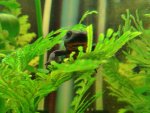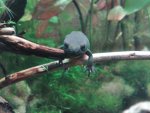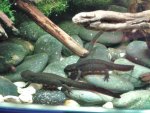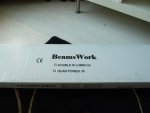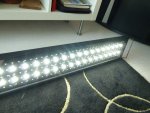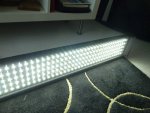AeonMapa
New member
- Joined
- Aug 2, 2013
- Messages
- 232
- Reaction score
- 8
- Points
- 0
- Location
- Manila
- Country
- Philippines
- Display Name
- Aeon
Ok, so I've been feeling like a huge hypocrite lately telling people to put their newts in 10 gallon tanks while I'm housing 5 newts in a 9 gallon. If you remember, about a month ago I introduced two pregnant cherry shrimp. Well they hatched and the number of baby shrimp is staggering. They aren't taking up much space yet, but if they are all going to reach the size of my adults, the tank will be stuffed in them. I've removed my minnows some time ago to keep the bioload down, but I am aware my tank is horribly crowded. The newts don't seem to be adversely affected, and you've all seen pictures of how healthy they are, but I really want them in a larger home. I'd like to set up a very beautiful home for them, and I'd really appreciate the input of the more experienced keepers, especially those with planted tank experience. Please bear with all the questions i'll be asking, as I want to provide the best habitat possible. Thank you in advance for the help, let's make us a newt paradise 
So first I have some questions about the volume of the tank:
1. How many gallons is recommended? I must admit though that I probably have no space for anything over 20 gallons :/
2. I'm planning to have a custom tank built, since you can get them done for under 20$ here! I want to go for a larger footprint than depth. What is a good depth? Right now mine are kept at about 20 inches depth, I love seeing them swim, but a wide tall tank might be too heavy for my desk. Would a depth of about 12 inches still be optimal?
Next I have some questions about land areas.
3. Having a larger space, I'd like to create a elaborate planted land area as well. How does one go about creating one in the middle of a 1 foot deep tank? I was thinking about putting a garden pot, but I'd really prefer something 100% natural.
4. Would terrestrial mosses, bamboo plants and vines be alright to keep on the land area?
5. Would it be better to skip the island all together and just go for floating mats? It would be nice to have planted land area, but optimal conditions is my goal.
Next some planting questions:
6. All my plants are currently potted but I'd like to go for a soil planted tank for this one. I've been keeping an unfiltered tub outside with a soil bottom and about 30 plants growing where they can get sunlight. I've kept a gourami and some danios in it, and it's built a population of pond snails. It's been established for 3 months now, and all the animals inside it are 100% healthy. So the question is can I take the soil and the plants from this tub and use it in my tank? I don't care if pond snails hitch a ride.
7. If the above soil is not appropriate for use, how to go about preparing soil for tank use?
8. Suggested plant species?
Now some substrate questions: This is what I'm most unsure about.
9. Is there any special maintenance required for a soil substrate? Stirring, vaccuming, etc.
10. I'd like to cover my soil with another substrate, since it soil is easily stirred up and clouds the tank. I was thinking about holding it down with a thin layer of sand, then a layer of the white pebbles and river rocks I'm already using. (I was thinking that it would make cleaning easier, since I'd just have to vaccum the pebbles and rocks) Would this be a suitable substrate? Or would it be very difficult to maintain?
11. Recommended substrates? I really have my heart set on a soil bottom for plants, but I'm willing to listen.
Tank cycling and filtration questions:
12. So if I use the aforementioned soil an plants, as well as the sponge filter, rocks and plants from my established tank, do I even need to cycle the tank? I'll obviously keep it running for 2 days after set up to make sure everything is fine, and to let the water clear, but can I move the animals in after that?
13. Can this set-up remain unfiltered? I know the newts won't need one, but I plan to keep my colony of shrimp there as well and they might need the air? I plan to put an INSANE amount of plants. I do have my established sponge filter which barely moves the water, and I use primarily as an aerator.
14. Currently, when my tank gets some sediments floating about, I run the power filter for an hour to clear it. What can I do about sediments in the new tank? Should I purchase a filter for this?
Cooling questions:
15. Will more water hold temp better?
16. Any insulation suggestions? I was planning to cover only the back of the tank though, but maybe something I can put under?
Décor questions:
17. Lots of driftwood and bogwood. Maybe some large hollow bamboo tubes for hides. Everything is treated beforehand of course. Is this suitable?
18: 3d background on the inside of the tank or paper stuck to the outside?
ANTI SCAPE! questions:
Ok so I've had two "impossible" escapes so I wanna do this right.
19. Will a wooden top with a two inch rim be suitable to prevent all escape? Or should I install a screen? I'd be willing to make the rim 3 inches if it prevents using a screen. Would would wood be too easy for them to climb around on?
20. Say I put a land area in the middle of the tank, and on that land area I put some bamboo plants that are tall enough to grow above the rim of the tank. This will be about six inches from the edge in every direction. Is this an escape hazard?
These are my basic questions, I wouldn't want to overwhelm you all any more than I might already have. Answers to any or even all of the questions is super appreciated, as are any suggestions you might have. I'm hoping to set this up around November
So first I have some questions about the volume of the tank:
1. How many gallons is recommended? I must admit though that I probably have no space for anything over 20 gallons :/
2. I'm planning to have a custom tank built, since you can get them done for under 20$ here! I want to go for a larger footprint than depth. What is a good depth? Right now mine are kept at about 20 inches depth, I love seeing them swim, but a wide tall tank might be too heavy for my desk. Would a depth of about 12 inches still be optimal?
Next I have some questions about land areas.
3. Having a larger space, I'd like to create a elaborate planted land area as well. How does one go about creating one in the middle of a 1 foot deep tank? I was thinking about putting a garden pot, but I'd really prefer something 100% natural.
4. Would terrestrial mosses, bamboo plants and vines be alright to keep on the land area?
5. Would it be better to skip the island all together and just go for floating mats? It would be nice to have planted land area, but optimal conditions is my goal.
Next some planting questions:
6. All my plants are currently potted but I'd like to go for a soil planted tank for this one. I've been keeping an unfiltered tub outside with a soil bottom and about 30 plants growing where they can get sunlight. I've kept a gourami and some danios in it, and it's built a population of pond snails. It's been established for 3 months now, and all the animals inside it are 100% healthy. So the question is can I take the soil and the plants from this tub and use it in my tank? I don't care if pond snails hitch a ride.
7. If the above soil is not appropriate for use, how to go about preparing soil for tank use?
8. Suggested plant species?
Now some substrate questions: This is what I'm most unsure about.
9. Is there any special maintenance required for a soil substrate? Stirring, vaccuming, etc.
10. I'd like to cover my soil with another substrate, since it soil is easily stirred up and clouds the tank. I was thinking about holding it down with a thin layer of sand, then a layer of the white pebbles and river rocks I'm already using. (I was thinking that it would make cleaning easier, since I'd just have to vaccum the pebbles and rocks) Would this be a suitable substrate? Or would it be very difficult to maintain?
11. Recommended substrates? I really have my heart set on a soil bottom for plants, but I'm willing to listen.
Tank cycling and filtration questions:
12. So if I use the aforementioned soil an plants, as well as the sponge filter, rocks and plants from my established tank, do I even need to cycle the tank? I'll obviously keep it running for 2 days after set up to make sure everything is fine, and to let the water clear, but can I move the animals in after that?
13. Can this set-up remain unfiltered? I know the newts won't need one, but I plan to keep my colony of shrimp there as well and they might need the air? I plan to put an INSANE amount of plants. I do have my established sponge filter which barely moves the water, and I use primarily as an aerator.
14. Currently, when my tank gets some sediments floating about, I run the power filter for an hour to clear it. What can I do about sediments in the new tank? Should I purchase a filter for this?
Cooling questions:
15. Will more water hold temp better?
16. Any insulation suggestions? I was planning to cover only the back of the tank though, but maybe something I can put under?
Décor questions:
17. Lots of driftwood and bogwood. Maybe some large hollow bamboo tubes for hides. Everything is treated beforehand of course. Is this suitable?
18: 3d background on the inside of the tank or paper stuck to the outside?
ANTI SCAPE! questions:
Ok so I've had two "impossible" escapes so I wanna do this right.
19. Will a wooden top with a two inch rim be suitable to prevent all escape? Or should I install a screen? I'd be willing to make the rim 3 inches if it prevents using a screen. Would would wood be too easy for them to climb around on?
20. Say I put a land area in the middle of the tank, and on that land area I put some bamboo plants that are tall enough to grow above the rim of the tank. This will be about six inches from the edge in every direction. Is this an escape hazard?
These are my basic questions, I wouldn't want to overwhelm you all any more than I might already have. Answers to any or even all of the questions is super appreciated, as are any suggestions you might have. I'm hoping to set this up around November

